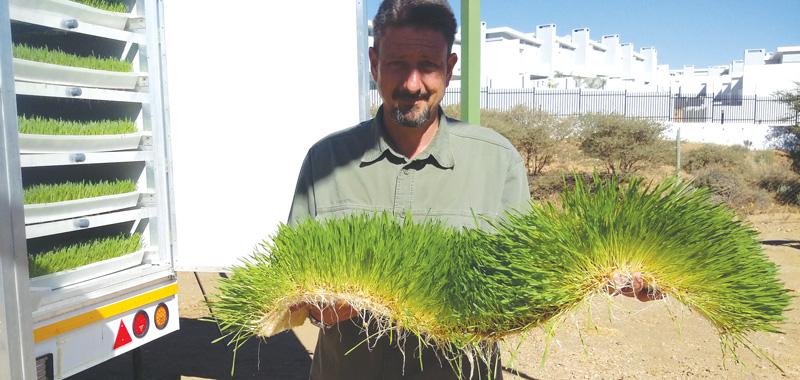
Climate Smart technology trials a success

A climate smart agricultural solutions company has relocated to Namibia to focus on delivering climate smart technology with agricultural applications.
Agri GreenGrow specializes in Controlled Environment Agriculture with the focus on aeroponic fodder production as well as tree planting technology.
The sustainable, smart controlled agricultural technology increases the adaptive capacity of farmers, communities and governments to respond to the impacts of climate change.
Keith Thompson from AgriGreen Grow, speaking to the Economist said that introducing new technology to people is a challenge, but approached it on a “show me, don’t tell me” basis.
”Therefore we undertook a number of successful demonstrations, trails and pilot projects through the year proving that our solutions are not only effective but also sustainable.”
The agri-business start up this year held beef cattle feeding trails in the Oshana region in cooperation with the Oshana Regional Livestock Marketing Cooperative in which he says proved the effectiveness of their green feed on cattle in the Northern Communal Areas.
“Our aeroponic fodder units are housed in a totally enclosed environment where outside ambient temperatures can vary from -15°C to +50°C without affecting the growth output.”
Thompson believes that there is definitely an interest to understand that new technology is needed to create the resilience required against droughts and climate change.
With this housed climate control unit sizes vary from the smallest producing 280kg of sprouted fodder everyday up to 10 tons per day. The fodder grow units use on average 96% less water than conventional planting methods.
To produce 1kg of feed 2,5 liters of water is used over the 7 day growing period. Conventional methods use 80 liters of water to produce the same 1kg of feed. The growing units are also designed using power saving equipment to ensure that production costs for the green feed is minimized wherever possible.
The growth cycle from seed to feed is 7 days with a continuous daily output. The units are also designed to work off either normal electricity or solar power.
“The fodder is also completely free of agricultural chemicals such as fertilizers and insecticides creating a resilience in Namibian farming, particularly in the livestock sector and is the technology by which livestock productivity can be accelerated and improved significantly.
“Human nature in essence is always hesitant when it comes to new ideas and technology. But we have gone from the standpoint of proving our climate smart technology through initiating trials and projects throughout the country.
“The rewards are now being reaped”,Thompson said as Agri GreenGrow will start with a number of major projects throughout Namibia early in the new year. “Although we started out in South Africa, Agri GreenGrow is now a fully Namibian company focusing on delivering climate smart technology to Namibians,” he said.
The tree planting technology is called The Groasis Waterboxx plantcocoon which is designed to grow trees in the desert, reforesting areas with irregular rainfall or poor and/or rocky soil. The Waterboxx plantcocoon provides the ability to plant wood and fruit trees, medical plants, garden vegetables and even vine crops in arid areas.
This self-replenishing water device is also referred to as a “water battery” which imitates nature with the use of biomimetic technology. Explaining, Thompson said that the bowl shaped plate’s goal is to create a micro climate for the survival of newly planted trees and seedlings during their first year of growth when they are most vulnerable.
The Waterboxx protects the plant and surrounding soil from direct sun exposure and prevents evaporation of the capillary water, ensuring that 100% of the water reaches the plant in its first year and helps the plant to grow its natural tap roots to a depth where groundwater is more easily reachable.
This simple technology uses only 60 litres of water in the first year and nothing further, there is a huge cost saving when compared to other conventional tree planting methods, for example drip irrigation that uses on average 5 litres of water per day per tree.
Both simple yet cost effective technologies seem sustainable.”Our technology now provides cattle farmers with the opportunity to fatten and sell animals throughout the year, instead of once a year when it has hopefully been a good rain season.”
“If you know how much feed you have every day of the year, you can now plan your farming productions accurately without being reliant on weather conditions. Our technology furthermore gives rangeland the chance to recover after periods of drought.”
Because our units vary in size it can be successfully used from a small scale farmer to large operations. Our units are also modular, therefore if a farmer or commercial operation wants to expand, we just add another unit to fill the daily feed requirement.
Not only do we provide the aeroponic fodder grow units, but we are also currently busy assisting our clients with the design and operation of cattle and sheep feedlots.












































